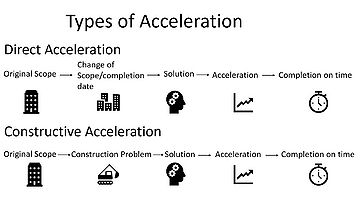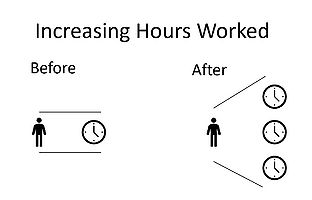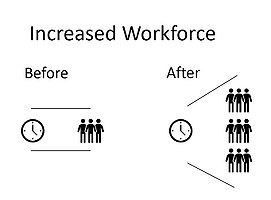Crisis Management in Construction Projects
Written by William Durant Mangum
Abstract
A project is a temporary endeavor undertaken to create a unique product, service, or result [1]. Many construction projects are often subject to crises during their lifetime and must either be overcome by managers to achieve the perceived benefits, or the project will fail. A crisis is seen as “a situation faced by an individual, group or organization which they are unable to cope with by the use of normal routine procedures and in which stress is created by sudden change.”[2]. While having potential disastrous affects, also offer an opportunity to align the team implementing the project, and also opportunity for improvement of potential benefits [3]. In the context of construction projects, crisis is usually something that disrupts the construction from continuing or causes the project to be extended. It should be noted that the purpose of crisis management is not only to prevent all crises, but to minimize the negative effects, have a quick and high-quality response, and to best prepare for all foreseeable crises. The main goal of this article is to cover the various tools project managers have to prevent crises in in construction projects, and the available tools to mitigate the negative effects of the crisis. Crisis Management in construction projects offer unique challenges because of the incredible uncertainty and immense initial capital investment at the beginning of construction in contrast to other types of projects.
The Importance of Crisis Management in Construction
It is important to note the traditional system of procurement and tendering in construction projects is what leads to the importance of counteracting against crises. Through the process of traditionally procured projects, construction has two distinct phases of design and production. An architecture firm is usually hired by a client to oversee both, and one of the most important part is the tendering phase. In the tendering phase, a main contractor is selected to complete the construction usually normally based on lowest cost. The client then enters a direct contractual arrangement with the contractor and the bill of quantities becomes a binding document to which the contractor is paid. Then the constructor must complete the project, often using sub-contractors, with considerably penalties if finished late. Time and cost over-runs are common in modern construction. [2] There are three main causes of this extra risk. The first being the increasing complexity of client needs and technological advances have led to very complex buildings requiring specialization and fragmentation, which has led to a need for much greater managerial ability. Second, the traditional procurement process is purely sequential. However, clients increasing the urgency has caused the design and construction phases to overlap. The final reason being the abuse of competitive tendering has led to restrictively-low margins, which lead to lack of trust and confrontational relationships. With the uncertainty of construction leads to a hostile environment for project managers, which is why learning how to deal with crisis is so important. It has also led to improved predictive and preventative techniques. [2]
Principles of Crisis Management
As stated previously, a crisis is “a situation faced by an individual, group or organization which they are unable to cope with by the use of normal routine procedures and in which stress is created by sudden change.”[2]. Crises are also characterized by a high probability of occurrence. [3]
Crisis types
In general, there 6 major crisis types. Those being:
- External Economic Attacks- Extortion, bribery, boycotts, hostile takeovers
- External Information Attacks- copyright infringement, loss of information, counterfeiting, Rumors
- Breaks- Recalls, Product Defects, Plant Defects, Computer Breakdowns, Poor Operator errors, Poor Security
- Mega Damage- Environmental Accidents
- Occupational health Diseases
- Perceptual- Damage to reputation
- Psycho- Terrorism, Copycats, on-site Sabotage/tampering, off-site sabatoge/tampering/sexual harassment, rumors.
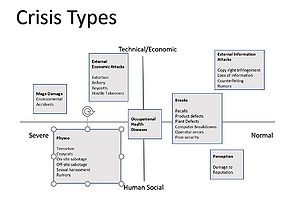
Change in Construction Crisis
Three managerial ironies emerge during a construction crisis. At a time when effective communication is important it is less likely; at a time when mutual sensitivity between project members is important it is less likely; and at a time when collective responsibility and teamwork are important they are less likely[5] .These ironies can be observed through four theorized components. These are Social Adjustment, behavioral instability, social structure and diametric opportunities.
Social Adjustment:
During crises, the normal patterns of social interaction are broken up as various interest groups, individuals, and organizations try and influence activities in one way or another. This creates tension between the forces of maintenance and change, as often the different groups are motivated by different interests. Interest groups will often display behavior to try and control the social structure ensuring resource distribution goes in their favor. The new social structures that emerge after a crisis are shaped by the overlap of interests, the balance of power, the sensitivity of managerial intervention, and the occurrence of natural environmental events. [6]
Behavioral Instability:
Crisis have a destabilizing effect, which is why the management of unpredictable behavioral change is so important in crisis management. In crises, people become desensitized to the needs of others, which creates further tensions. Management must give continuous attention to the maintenance of stability. Any instability is more likely to gain traction and momentum towards negativity, which becomes extremely difficult to break. [6]
Social Structure:
Social structure is key in crisis management, because the social structure that emerges has direct effect on the reaction efficiency. The reaction efficiency is directly related to the social structure through the speed at which information is transmitted between groups. There are certain structures which ensure a smoother transition of information than others. This efficient information flow reduces the uncertainty levels driving a chain reaction in the reduction of misunderstanding, disjointedness, disagreement, frustration, tension, and conflict. This in turn reduces the time of resource redistribution and the efficiency and effectiveness of the response to crisis. How people align themselves within interest groups of an organization can reinforce, weaken, or reverse the influences of structure upon efficiency. [6]
Diametric opportunities:
External factors outside the control of project participants will have a direct role in creating a supportive or destructive to the efforts of crisis management. Destructively, a crisis can induce managerial inertia and discourage the collective responsibility, teamwork, and effective communication when they are most needed. This managerial inertia tends to create a negative cycle prolonging the crisis and wasting managerial resources. Constructively, a crisis can provide opportunity for increased cohesion, harmony and efficiency. The constructive cycle can also shorten and reduce the investment of managerial resources in a crisis. [6]
The five phases of Crisis Management
The five phases of Crisis Management
- Signal Detection
- Preparation/prevention
- Containment/damage limitation
- Recovery
- Learning
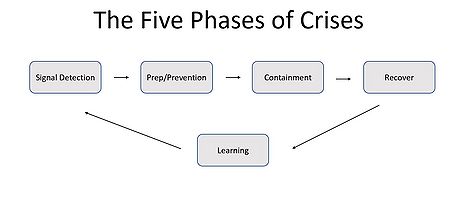
Signal Detection
Under very few exceptions do crisis occur simply without warning. Normally there are early warning signals that a crisis may be approaching. Think for instance of a car. A car will often give out strange noises or sticking between gears long before the transmission gives out. A successful project manager is able to see the red lights and act accordingly. [4]
Preparation/prevention
The best project managers prepare for crises systematically and continuously. A car whose oil is changed regularly is going to have a much lower chance of engine failure than a car whose oil is never changed. [4]
Types of preventative actions in general crisis management
- Audits - Legal/ Financial audits, legislation, reduction of inventories, environmental impact audits
- Internal Repair Design – Improved Safety, Plant Design, Product Packaging Inspection, Organizational Chain of Command
- Internal Emotional Preparation- Whistle Blowers, Emotional Preparation, Employee classes, behavioral Profiling.
- External Info/Communication- Issues Management, Warning Systems, Government Relationships, Share Plans, Media Training, Behavioral Profiling.
Containment/damage limitation Under damage containment, an event has occurred that passed by the first two steps. A project manager’s job now is to create a detailed plan to prevent the localized crisis from affecting other portions of the project and its environment. If the car’s tire explodes, it is best to pull over and make sure that further damage is not done to the axel, breaks, or ball joints. [4]
Recovery Projects that are well prepared then enter the stage of recovery. After the tire exploded, now the driver has a spare donut tire to put on the car to get to a local mechanic to buy a new tire. [4]
Learning The final stage, and possibly the most important for any project manager, is learning from the crisis and putting that information to use when looking for future signals. This requires critical examination and adequate reflection. Maybe it is a better idea to take the paved road, instead of the gravel road, so in the future the tire does not pop.
A perspective offered from proactive to reactive is offered by the article “Effective Crisis Management” and outlined in the figure.
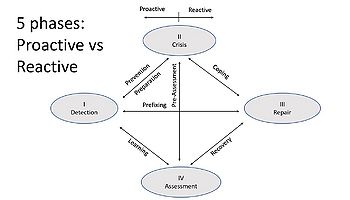
The 5 phases of Crisis Management in Construction
- Signal Detection- Listening to worker/engineer worries and complaints, accepting feedback from detection mechanisms.
- Preparation/prevention - Giving more breaks to workers to improve moral, checking the battery levels of equipment etc.
In the context of Construction Crisis, some of the more specific actions one can take in preventive actions include
- Creating a positive approach to crisis management
- Obtaining trust by achieving the responsibilities in activities
- Being ready for opportunities of crises
- Forming a competitive crisis management team
- Determining potential types of crises
- Improving policies to prevent potential crises,
- Developing strategies and tactics to struggle with potential crises,
- Determining risk and crisis control procedures
- Forming and testing crisis plans and scenarios
- Containment/damage limitation- In construction projects, this may include a cleaning up after an oil spill or sending a sick worker home early before he infects other construction workers.
- Recovery- This may mean hiring a new crew member after another quit, or having a mechanic come and fix the heavy machinery.
- Learning- having a mechanic more regularly check on the machinery, or introduce sometime of KPI system to better monitor worker satisfaction. [4] Some activities a construction company should take are listed below
- Organizing systematic training programs for all employees
- Rehabilitating the working environment
- Rewarding successful personnel because of their valuable performances in the crisis process
- Turning the crisis management team into the solution development team
- Preparing strategic reports for a long-term productivity and efficiency program
Specific tools of Crisis Management in Construction
Besides using the more general crisis management tools in the context of construction, there are also tools specific to construction.
The Five Approaches
There are five main approaches specifically to construction management. These five approaches are divided into proactive and reactive.
Proactive
- The escaping approach
- The solving approach
- The proactive approach
Reactive
- The reactive approach
- The interactive approach
In the escaping approach, one must follow the internal and extern environment constantly. With that information, one can predict around a crisis. In Construction, the role top management plays is establishing the projected objectives, inform personal on the policy, share values, and transfer their philosophy. It is also the top managements responsibility to find effective solutions, establish a flexible and enthusiastic company culture, and dynamic company structure. The top management should often follow negative macroeconomic indicators such as inflation rates, interest rates, unemployment rate, or political and international crises. [7] The solving approach is dependent on the prediction of conditions before a crisis and quick movement in problem resolutions. The crisis conditions should be identified clearly and reacted to in a realistic and patient manner. There should be systematic compilation of material for effective decision making, extra opportunities from staff at different levels, reducing time pressures, and a detailed identification of the crisis sources. There are many criteria a construction company should consider during a crisis:
- A crisis can also bring opportunities.
- Competition strategies should be determined exactly.
- Strengths in the strategic competition should be analyzed deeply.
- Internal savings should be paid attention.
- Investments that can provide a high financial return in the short term should be given priority.
- Personnel should be motivated against crises.
- Competitors and changes in real estate and construction markets should be followed.
- The customer satisfaction should be the main philosophy.
- Long term investments should be refrained.
- Advertisement and promotion activities should be performed.
- Qualified labor should be preferred.
- Defensive strategies should be followed.
- Costs should be decreased instead of the amount of production.
- Trading activities should be based on cash instead of the amount of sales.
Besides these criteria, a construction company can also perform a SWAT analysis to determine further opportunity. [7]
The proactive approach states that top management should produce alternative solutions against potential crises. A company that is proactive and adapt production and marketing activities to crisis conditions, and thus out compete competition. In this strategy, the following items should be established.
- Providing correct and adequate information.
- Determining risks.
- Establishing early warning systems.
- Making a prevention plan.
- Forming a crisis prevention team.
In the Reactive Approach, the construction company is under an unexpected crisis. The reaction in these situations is usually aggressive and shortsighted. Normally one or more of the following are enacted:
- Shrinkage
- Closing some departments
- Deduction in salaries
- Unpaid vacation
- Restriction in Extra Services
- Dismissal
The interactive Approach seeks to incorporate the stakeholders in the learning process. When assessing the before, during and after, the construction company seeks to incorporate the stakeholder in order to establish trust, offer different perspective, and prevent further crises.
Acceleration of Project
Sometimes a construction project will go through an acceleration of activities. The activities acceleration is to shorten the overall duration of a project. By increasing the resources or by adding more working hours, a certain activities duration can be shortened, making up for costs due to crisis. If the activities included is part of a critical pathway, the entire project will be quicker. Three reasons one may accelerate activities include [8].
- Trying to finish faster for to avoid penalties in contracts.
- Certain seasons offer better working conditions to quicken the project.
- The cost of quickening the procedure may be lower than the overhead cost of finishing the project on deadline.
There are two types of acceleration activities, direct and constructive. Where direct when the project is forced to be finished quicker, or the scope is made greater, and constructive acceleration is when the construction company simply must complete the project on the agreed upon timeline. [8]
One can accelerate activities by improving the productivity of current resources, change the working method/reduce work content, reduce lead time for material delivery, or increase the quantity of productive resources.
After these types of measurements are taken, employees, customers, and customers may lose trust. This should be considered in the overall scope of the project and especially with Key stakeholders who may be affected by the acceleration. [8]
When considering adding overtime, it should also be noted that the productivity of workers decreases by the hour. This is due to fatigue and boredom, tidying up the workplace, and the reluctance to begin a new task. [7] In theory, there are three pillars of successful response to unexpected events. These pillars are based on the perspective of organizational level, group level, and individual level within a project.
Successful Response to Crises
From an organizational Level, successful response is based on having a responsive and functioning structure, which allows for a high degree of freedom and pace to make and implement decisions. From a group level perspective, the success is dependent on good personal relationships. This is defined by a high level of stakeholder engagement and the ability to negotiate, and good communication based off high availability of information. Finally, at the individual perspective, it is expected for a person to be competent. This is further broken down into a competent leader and team, as well as self-awareness and ability to deal with stressful situations.[9]
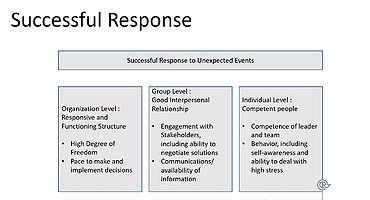
Perspective of Crisis
There are two main ways one can view crisis, internal and external. These are important as it will affect how the project is perceived. It the internal and external perspectives can be divided into 3 stages; pre-crisis prevention, crisis management, and post-crisis outcomes. This can be viewed in the chart.
It is important to note the external views as a project manager, because the success of the project is often dependent upon the social views and stakeholder perception of how the organization resolves the crisis. [10]
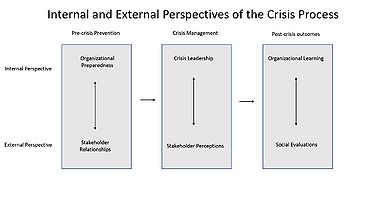
Final Discussion
Limitations
One of the major Issues with PMBOK is in fact it’s lack of mentioning crisis management [11]. Indeed, the word crisis is only mentioned once in PMBOK and never in Prince2. While both give preventative measures such through risk management, much of which can be found in other places of this wiki, in the future, both Prince2 and PMBOK should consider including a section dedicated to crisis management.
It is to be noted while there is much research in construction crisis management in regards to theory formulation, communication structure, contractual conditions, real estate-based analysis, triple constraints composed of communication, sensitivity, and responsibility, environmental and organizational factors, organizational behavior, reactive communication and behavior disorganization, preparedness, social adjustment , and social network analysis, there is a huge lacking in the investigation of management practices. [7]
Conclusions
The four different components of Social Adjustment, behavioral instability, social structure, and diametric opportunities clarify the distinctiveness of crisis management in context of construction.
Crisis is a good time to take corrective actions relative to the project, due to the consent and full acceptance given by the team members. Potential benefits of the effect of the crisis may materialize in the project, when the project manager along with the project team learn to observe the surroundings and analyze the crisis symptoms.[3] Crises do not develop in a short period of time, either. Typically, they develop gradually, sometimes even systematically, in the wake of a number of events combined by the cause-and-effect relationship.[3]
Crisis may also cause a decline in economic activity of the conducted undertaking and reduce its competitiveness. An inadequate response of a project manager to the crisis, which manifests itself in making erroneous decisions, can really weaken the company and accelerate the escalation of the crisis.[3] Under minimum loss circumstances, a construction company should return to pre-crisis restricted expenditures, centralized management, and low-level managers’ suspended authorities. [7]In addition, high-performance personnel may be rewarded while low-performance ones may be fired. While creating special crisis management teams can be a successful technique to control crisis management in construction, the heart of crisis management lies the people assets. This is especially seen in terms of stakeholder engagement, negotiation, and leadership skills. (Geraldi, Lee-Kelley, & Kutsch, 2010) Finally, permanent commercial relationships with suppliers and customers should be reviewed for an innovative crisis management process. [7] In the future, more research should be done in managerial practices of construction companies in crisis offering managers more concrete data when making crises decisions.
Annotated Bibliography
Loosemore, M. (1999). A grounded theory of construction crisis management. Construction Management and Economics, 17(1), 9–19. https://doi.org/10.1080/014461999371781
Summary: Loosemoore aims to give a theory on construction crisis management emphasizing the various behavioral changes an organization undergoes during crisis including social adjustment, behavioral instability, social structure, and diametric opportunities.
Loosemore, M., & Hughes, W. (2003). Reactive Crisis Management in Construction Projects - Patterns of Communication and Behaviour. Journal of Contingencies and Crisis Management, 6(1), 23–34. https://doi.org/10.1111/1468-5973.00065
Summary: Emphasizes the difference between construction projects and the unique challenges it faces. Gives a good insight into the uncertainty faced in construction. Also explores the social adjustment, behavioral instability, social structure and diametric opportunities.
NN Pearson, C. M., & Mitroff, I. I. (1993). From crisis prone to Crisis prepared: A Framework for Crisis Management. The Academy of Management Executive, 7(1), 48–59.
Summary: A general approach to crisis management, but gives in depth theory on the causes of crises and also the ways to prevent them. The five phases of crisis are outlined here, as well as the various variables in crisis, such as stake holders.
Sahin, S., Ulubeyli, S., & Kazaza, A. (2015). Innovative Crisis Management in Construction: Approaches and the Process. Procedia - Social and Behavioral Sciences, 195, 2298–2305. https://doi.org/10.1016/j.sbspro.2015.06.181
Summary: This article gives very specific approaches to construction crisis management. It aims to give concrete reactions in crisis situations.it also gives a valuable perspective of the five phases of crisis in relation to construction.
References
- ↑ 1.0 1.1 Project Management Institute, Inc.. (2017). Guide to the Project Management Body of Knowledge (PMBOK® Guide) (6th Edition). (pp. 3). Project Management Institute, Inc. (PMI). Retrieved from https://app.knovel.com/hotlink/toc/id:kpGPMBKP02/guide-project-management/guide-project-management
- ↑ 2.0 2.1 2.2 2.3 Loosemore, M., & Hughes, W. (2003). Reactive Crisis Management in Constructive Projects - Patterns of Communication and Behaviour. Journal of Contingencies and Crisis Management, 6(1), 23–34. https://doi.org/10.1111/1468-5973.00065
- ↑ 3.0 3.1 3.2 3.3 3.4 Nowica, A. G., Tomasz, J., & Wilska, E. (2017). Project management in crisis situations. Torun Business Review, 16(2), 53–62. https://doi.org/10.19197/tbr.v16i2.110
- ↑ 4.0 4.1 4.2 4.3 4.4 4.5 4.6 4.7 NN Pearson, C. M., & Mitroff, I. I. (1993). From crisis prone to Crisis prepared: A Framework for Crisis Management. The Academy of Management Executive, 7(1), 48–59.
- ↑ Loosemore, M. (1998). The three ironies of crisis management in construction projects. International Journal of Project Management, 16(3), 139–144. https://doi.org/10.1016/S0263-7863(97)00041-0
- ↑ 6.0 6.1 6.2 6.3 Loosemore, M. (1999). A grounded theory of construction crisis management. Construction Management and Economics, 17(1), 9–19. https://doi.org/10.1080/014461999371781
- ↑ 7.0 7.1 7.2 7.3 7.4 7.5 7.6 7.7 Sahin, S., Ulubeyli, S., & Kazaza, A. (2015). Innovative Crisis Management in Construction: Approaches and the Process. Procedia - Social and Behavioral Sciences, 195, 2298–2305. https://doi.org/10.1016/j.sbspro.2015.06.181
- ↑ 8.0 8.1 8.2 Halloum, M. (2010). Project Crisis Management Techniques to Overcome the Problems of Schedule Delays and Cost Overruns, 202.
- ↑ 9.0 9.1 Geraldi, J. G., Lee-Kelley, L., & Kutsch, E. (2010). The Titanic sunk, so what? Project manager response to unexpected events. International Journal of Project Management, 28(6), 547–558. https://doi.org/10.1016/j.ijproman.2009.10.008
- ↑ 10.0 10.1 Bundy, J., Pfarrer, M. D., Short, C. E., & Coombs, W. T. (2017). Crises and Crisis Management: Integration, Interpretation, and Research Development. Journal of Management (Vol. 43). https://doi.org/10.1177/0149206316680030
- ↑ LaMarsh II, W. J., & Landaeta, R. (2005). Is crisis management a new knowledge area needed for the PMI? Paper presented at the 26th Annual National Conference of the American Society for Engineering Management 2005 - Organizational Transformation: Opportunities and Challenges, ASEM 2005, 325-329. Retrieved from www.scopus.com
- ↑ Template:Cite book
